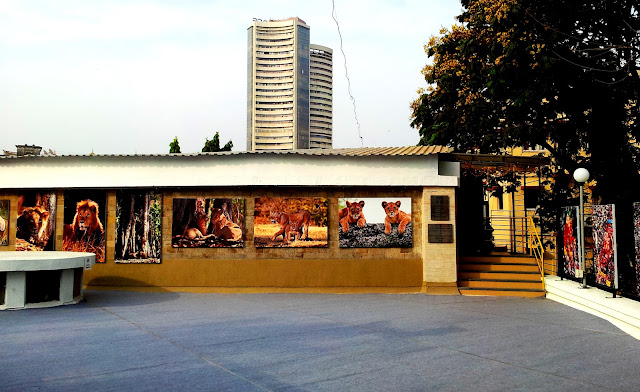Once, just once in a while, does our city give back to its citizens. More through serendipity than through design, but who are we to complain? A new al-fresco space has been made accessible to the public at large, taking them off the streets around Kala Ghoda and elevating them one level above it, and allowing for a new vantage point from which to observe the beating, beating heart of South Bombay.
Through a an act of munificence, veteran photographer Kakubhai Kothari has set up a simple new gallery on the terrace of the Jehangir Art Gallery devoted exclusively to photography. The Gallery is itself small, an asymmetrical room of one straight and one curved wall, enough to hang about 24 midsized frames. This space was, for many years, the former studio of the water colorist who would sign his work as, simply 'Chetan'. Now back in the possession of the Jehangir management, this reconverted space shall, hopefully, be the venue for many exhibitions of photographs. The first one, appropriately enough, is by Kothari himself and he has put up several large unframed images of tigers that he photographed in the Bandhavgad, Sariska and Tadoba reserves.
What supersedes the new gallery, to me, is the terrace itself that I have to first traverse to get to the photographs. Reaching the top, having climbed the refurbished steel staircase next to the Samover, I realize how large the terrace is, and (reflecting the lobby and galleries below) how it is broken up into several footprints. It is currently, perhaps quaintly, carpeted over (see image) but I doubt this will last the monsoon. Nevertheless, (and am I speaking too soon here?) there is a potential for this space to be put to use in a variety of ways, should the management appreciate this.
Standing on the terrace looking to the West, I can observe life in the Kala Ghoda parking lot. In this, I am not alone. The lot has, for more than a century now, been overseen by a portentous head of Sir David Sassoon,
"...stuck like a schmuck up here
-an ahmaq.
a certified keer-e-khar –
(David Sassoon)
I can now see the old man eye to eye, as he sticks his “pilloried head/ out of a medallion/ in the pediment above the archway...” of the building formerly known as the Mechanics Institute. The Army and Navy Building and the Elphinstone College on either side make up the line of neo-Gothic edifices, whose details one can appreciate better from this crow's nest. There is the precarious Watson's Hotel that I fervently pray will not collapse just because I am looking at it. From beyond, I can clearly hear the bongs from the clock tower named after Premchand Roychand's mum calling the faithful to paryushan. To the east looms the other tower, named after another Jeejeebhoy, aka the Bombay Stock Exchange, and I wonder why India's second most photographed building needed to have a monstrous neon sign capping it, just to tell me of its provenance as Babel and Sodom Inc.
But best of all, I can turn my head up and look up into nothingness, unafraid of getting run over, propositioned, or hauled up for loitering.
Arun Kolhatkar had the same idea:
"This is the time of day I like best,
and this is the hour
when I can call this city my own;
when I like nothing better
than to lie down here, at the exact centre
of this traffic island..."
(Pi-dog)
But I find myself at a point somewhat removed from the centre of the lot both along the x and the z axis, and I am overwhelmed with a desire to lie down on my back on the carpet and stare at the waning, pink rippled dusk. I stop myself, of course, out of a sense of decorousness. There are too many people around. A couple with far too many children are making their way up the stairs after asking whether there is anything to see. There is. The best thing about the Jehangir Art Gallery is its stellar location. The second best thing is that it is a space that has always been free to all. This terrace could be the harbinger of an opportunity to become another welcome public space.
This said, I have some hopes too:
I hope that the terrace space will always remain open.
I hope that the newly created gallery shall always be dedicated to the display of photography.
I hope that the terrace will inspire installations specific to the opportunities the site offers.
I hope that the management of Jehangir will consider some light trelliswork to shelter visitors during the summer months.
I hope that the edges of the terrace shall not be barricaded with safety features that obscure the views of the streets below.
I hope that this space will be made available for lectures and performances in addition to displays of art, and that these shall never be made exclusive.
I hope better sense (and taste) shall prevail, especially during the Kala Ghoda Festival, unlike the ritualistic buggering up that happens once every year of the parking lot below.
I hope that Samovar shall be allowed to set up an al-fresco eating place. There is enough space for this.
I hope the skyline that we grew up with and loved will never be obliterated because of DC Rule 33/7.
I hope the sky may never fall on my head.
“A twig! A twig! A twig! A twig!
You got it! You got it! You got it!
It’s all yours now.
You can take it away
Anytime you want
But first, examine it.”
(To a Crow)
(All the excerpted lines are from Arun Kolhatkar’s Kala Ghoda Poems, 2004, Pras)





